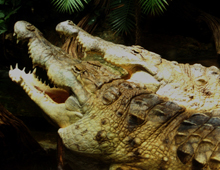Description: This large species is similar to the American crocodile. The body is made up of scales (scutes) that vary in shape and strength. Orinoco crocodiles can be identified by the arrangement of dorsal (back) armor with six prominent scales on the back of the neck. Osteoderms (bony deposits within each scale) are rough in texture and are often different in color. Orinoco crocodiles have no osteoderms on their light colored belly, Another identifying feature of the Orinoco crocodile is the narrow snout which slopes upward near the tip. The nostrils are set at the end to allow breathing while mostly submerged. The tongue is wide and attached to the bottom of the mouth and does not aid in the capturing of prey. Their body color varies from gray-green, tan, to gray scattered with dark green. The legs are short and strong; the long tail is quite powerful.
Size: Somewhat larger than American crocodiles, the male Orinoco crocodile at one time reached 22 feet (7 m) in length. The largest are now seldom more than 16 feet (5 m).
Behavior: Crocodiles, the largest predators in their habitat are very effective predators. Complex behaviors include: social interactions, dominance hierarchies, coordinated feeding and well- developed responses. They are normally quite sluggish unless feeding. The scutes not only provide protection, they also have a blood supply that enables these, cold-blooded reptiles to transfer heat when basking in the sun. Mouth-gaping while basking allows moisture evaporation of the large mouth area, lowering the temperature of the crocodile’s blood as it passes through the membranes with their extensive blood supply. They remain close to water to better maintain body temperature since water temperature shows less extreme variation than air temperature.
Diet: They are excellent opportunistic hunters, moving quietly and remaining hidden until striking out. Fish, birds and small mammals such as capybaras make up most of the diet of adult Orinoco crocodiles. Juveniles eat crabs, snails, insects and fish.
Senses: Crocodiles have well-developed senses of smell, seeing and hearing. They are sensitive to a wide frequency range. The eyes are close together, allowing for binocular vision. Protective membranes cover the eyes when underwater.
Communication: The use of communication by vocalization is unique among crocodiles. “Bellowing” is somewhat like the roar of a lion with males having a lower pitch than females. Hatchlings grunt or bark. Head-slapping is used for communication. The lower jaw rests on top of the water and the upper jaw slaps closed, causing a loud pop, followed by a splash. Tail thrashing is also used for communicating. An “infra- sound: that is barely audible occurs when the crocodile, near the water’s surface, twitches its body, causing reverberating waves. Crocodiles secrete an oily, musky odor that communicates their presence.
Reproduction: Crocodiles reproduce by means of eggs. Sexual maturity is indicated by size, (approximately six feet / 1.8 m in length) and age. The female Orinoco crocodile digs a hole in a sandbar or river bank during the dry season, in which she lays between 40-60 eggs. Eggs develop within the nest for 75-85 days. The temperature at which the eggs are incubated during the first few weeks in the nest determines the sex of the offspring. With an optimal incubation temperature variation throughout a nest, it is possible for both sexes to be produced in the same nest, particularly since they are not all buried at the same level. Though the female remains close to the nest, lizards and vultures are persistent predators. Hatching takes place just as the wet season begins.
Habitat/range: Orinoco crocodiles are the most southerly crocodiles in the New World. They are found in quiet lagoons and water of the Orinoco River basin in Venezuela and Meta River basin Colombia. During the rainy season they often leave the river and travel overland to nearby ponds and lakes, returning to the river when the water recedes. They excavate burrows where small areas of water remain in river banks, where they may live during the dry season in a dormant state (aestivate).
Status: Due to the quality of their belly skin and large size, hunters were able to make huge sums of money from killing Orinoco crocodiles. They are now on the IUCN Red List as Critically Endangered; CITES-Appendix I.



